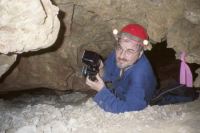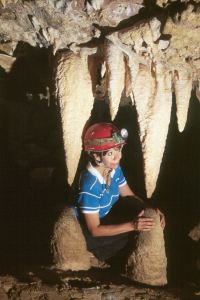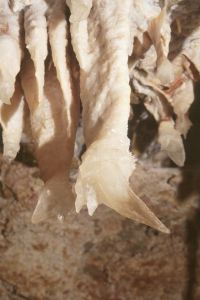|
DAHL SURPRISE
May 5, 1999. We were back in the desert and Spring was in the air, even
though the temperature of that air was 105 degrees F (42 C). Lars Bjurström
was driving Susy and me to a cave he had found only a few weeks earlier. As
we drove out of the little town of Shawiah -- which is almost completely
surrounded by sand dunes, Lars showed us what a 4WD can do once the tire
pressure is reduced to 15 pounds. We were amazed to see him plow into
extremely soft sand, stop on an upgrade and then crawl right out. We had
heard of using this technique to get unstuck, but Lars left the pressure low
all the time we were off asphalt with no problems and could easily drive
under the worst of all conditions.
As soon as we passed Shawiah, we saw Dhubbs galore scurrying hither and yon.
Before we arrived at Surprise, Lars showed us a small collapse which
revealed several very old-looking stalagmites whose tops are only two feet
below the surface level, obviously the floor of a cave long ago eroded away.
"And now, where is the entrance to Surprise?" asked Lars. Well, we wandered
all about looking for it, but you definitely can't see that small hole from
over a meter away.
Lars Bjurström found surprise cave after poking into countless other holes
on the As Sulb Plateau. His account of the discovery deserves to be told in
his own words:
DISCOVERYEarly Thursday morning I went to the cave area, planning to meet Lennart on
Friday. Lennart seems very interested and as crazy as me. It was a very
disappointing Thursday. I think I went down 12-15 holes, most of them
nothing. And nowadays I don't give up easily. In the afternoon I was dead
tired, bruised and with aching knees. I found one rather big one but
"hostile." By that I mean lots of tight passages, sharp and difficult floor,
gray, dusty, dull and with no decorations whatsoever. You can see it is
dead. At that time I was ready to give up caving altogether. A sheep herder
I met at a hole said: (in Arabic but I got the meaning) "Don't go down
there. There is nothing to see and it is dangerous. You are crazy!" And he
shook his head. I almost agreed with him, but I went down. When I came back
up, after rather a long time, he was still waiting for me and I could
clearly see he was surprised I was still alive. I also saw my first snake, a
small one that quickly disappeared.
On the way to my camp in the sand dunes I found one interesting hole close
to Friendly Cave but I decided to check it the next day with Lennart.
I had a nice, peaceful evening by myself in the sand dunes testing my new
car tent which is fixed to my new roof rack and which I can roll out to make
almost a bedouin tent. It worked fine. The sand was very firm after heavy
rain and it was really funny to drive up the highest hills with no
difficulty. Beautiful evening.
The next day I met Lennart at Friendly Cave. We had some difficulties to
find the cave he had told me about and I stopped at a small hole, not much
bigger than Dahl Sultan, to have a quick peak. I could chimney-climb down
approx. 7-8 meters and to my happy surprise (to say the least) a nice,
beautiful, cave presented itself! It was clean, big (I could walk upright),
nice, sandy, floor and with lots of really beautiful decorations. So I named
it Dahl Surprise. I walked as long as I dared but soon went back to get
Lennart. We brought all the marking line we had and started to explore it.
And it went on and on until we had no more line and did not dare to go
further. We were also very tired. But it is a major cave, that's for sure.
And friendly! No dead sheep, no really tight passages (except at the
entrance) and very beautiful. Also, the temperature is relatively cool . It
was lots of "My God!," "Sh--! "and "Wow!" Not to mention "It continues
further!" or "You have to see this, Lennart!" We stayed for three hours and
some very delightful hours they were. All my troubles from before vanished
with the wind.

Now I have to go back there with my camera and lighting gear and more
marking line, so we can go further. It is much bigger than Mossy Cave and
with lots more decorations than both Mossy and Friendly Cave. It has several
interesting branches that need to be explored. There are no signs of any
previous visits. It showed signs of really heavy flooding since some of the
flowstones and stalactites were ripped off. The stalactites look virgin,
white and clean with water still dripping from them. The flowstone is, at
some spots, just marvelous. I really needed and deserved this, I tell you.
On my way home it was a very happy Lars, playing the stereo full blast and
thinking of all those people back home who don't know how to live! Dahl
Surprise here I come!
Lars Bjurström, Copyright, 1999
We threw a handline down the hole and clambered about 15 meters to the
bottom, which doesn't look promising at all: a lot of dusty breakdown (thus
the name of the cave). Beyond this area, its a horizontal cave with lots of
walking passages and several big rooms. The floor is frequently sandy with
signs of water movement in recent times and the temperature in most parts of
it is cooler than Sultan and Mossy but not as chilly as in Murubbeh.
MYSTERIOUS NEEDLES AND STALACTITES
Resisting the nearly irresistible temptation to run off to the beauty spots
of this cave, we began surveying it right from the surface. The cave starts
out looking a lot like Sultan with thick, weirdly shaped tentacles reaching
forth from the ceiling and side walls. But even this part of the cave held
hints of things to come. Tucked away in a little alcove was a collection of
long, thin, gypsum needles, mostly straight, with one oddball describing a
funny, gravity-defying curve. After a while, we reached the Feathered
Column, covered with what may be tiny relatives of the snowy feathers of
Murubbeh. Just next to it are some stalactites that are "wrapped" with what
looks like a layer of translucent glass, plastic or bubble-wrap. For some
reason, this thick coating stops right at the bottom of the stalactite.
Looking straight up from below them, you can see that the outer layer is
completely separate from the older formation underneath. Here's a phenomenon
none of us have seen before... but we seem to be saying this with every new
cave discovered in Saudi Arabia!
By now, we were hungry, so we headed for the surface and drove off to a
great camping spot hidden among some nearby dunes and accessible only to
vehicles with nearly flat tires. Along the way, we saw quite a few
frolicking gerboas and in the night we found an unusually large number of
insects fluttering around Lars' Coleman lamp. One of these vaguely resembles
a small dragonfly, with wide, transparent wings. With Dhubbs a-running,
gerboas a-jumping and bugs a-fluttering, we speculated that the bats we
haven't seen for so many months might also be back in residence.
SAND FISH AND DHUBBS
Next morning we spotted an odd-looking lizard running along the big dune
next to us. It had shiny, silvery skin and when we came near, it dove
straight down into the sand and vanished. We dug down and found no trace of
this creature which we later learned is known as a sand fish.
We drove off to the cave around 8:30 AM, an ideal time for dhubb watching.
Actually, it was the dhubbs who were watching us while they were "warming
up" next to their holes and they would allow us to get surprisingly close
before diving out of sight.
Back in Surprise Cave, we surveyed our way to the Crystal Room. Here we saw
some very curious small white formations which seem to be composed of
discrete segments invisibly joined together, almost like three-dimensional
mosaics. the most striking of all looked something like a scorpion's tail.
At the far end of this room there's a wonderful set of stalactites and
stalagmites framing a "window" that Lars named The Dragon's Mouth. A great
many formations in this room were dripping water even though there had been
little rain this year.
THE SCORPION'S TAIL
The Crystal Room has three big passages leaving it. As we began to survey
one of them, a real tragedy occurred. Pulling the survey tape taught caused
it to whip over to a new position, snapping off the Scorpion's Tail. It's
impossible to describe how badly we felt about this. Because such a thing
had never happened to us before, we hadn't realized how easily a measuring
tape could be an implement of destruction in a delicate environment. The
Scorpion's Tail broke off intact and we hope we can glue it back in place.
(Lars Bjurström succeeded in doing this a few weeks later).

With much greater care, we continued surveying until we came to ... JAWS!
This is a set of two fang-like stalactites right above two stalagmites and
they really look menacing. Next we came to a rather muddy area where there
are two big stalactite displays that long ago cracked off and fell to the
ground. One of these, which must way tons, we called Fallen Glory. These
huge chunks-- plus many notable cracks throughout the cave -- seem to
suggest there was a mighty tremor in this area long, long ago. At last we
arrived at Perseverance Payoff, a passage Lars had figured went nowhere but
which Arlene Foss later followed back to what is to date the most amazing
set of formations in this cave. The Chandelier is a number of stalactites
which have been completely covered by the glass-like, nearly transparent
coating mentioned earlier. But in this case, the bottoms of the stalactites
are sealed. Then comes what is really weird: the tips of the stalactites
don't come to a point, but instead to a "ducktail" which is thin and flat
and -- get this -- is angled at about 45 degrees instead of pointing
straight down! In one case, the stalactite ends in a set of two ducktails
which resemble the separated leaves inside a Leyden Jar.

(On a subsequent trip, Dave Canning studied pieces of the "mystery coating"
lying on the ground. Apparently this room had also suffered damage from the
earthquake that tumbled Fallen Glory. Upon fracturing these pieces, Dave
decided that the mineral is calcite. Perhaps it was deposited not by flowing
down the stalactite, but by crystallization directly from the environment. I
don't know if the air is sufficiently saturated nowadays to cause this outer
layer to continue to grow, but I should mention that the Chandelier Room
probably has the highest humidity of any place I've crawled into in the
Desert Caves.)
GERBOA IN THE BEDROLL
A whole day had passed. We packed up and drove back to our campsite,
stopping to watch two gerboas (which look like kangaroo rats to me) playing
hide and seek under a bush illuminated by the car's headlights. They didn't
seem to mind our presence at all. Back at camp, we found Arlene and Lennart
waiting for us and spent the evening chatting around a campfire. The
temperature couldn't have been nicer and the sky was filled with brilliant
stars. Just before bedtime, Susy heard a scratching sound under Lars'
bedroll. We lifted up the blanket and found a baby gerboa wandering about,
which it kept doing even in the beams of our flashlights. Finally, it
scurried off to the underbrush and performed a series of amazing jumps
straight into the air.
The following morning our old friend the sand fish reappeared at about 8:00
AM. We soon learned you can walk up to them slowly and, after they "dive,"
just wait a bit for them to reappear. Lennart and Arlene took off for
Surprise Cave and we tried once again (without luck) to find Dahl Hashami.
Next, we went to Murubbeh to photograph the large, neatly folded animal skin
"blanket" we found there. Bones in the cave are about 1000 years old and
this skin may be of the same age. In the cave we found a lot of bats
(Trident) which had not been there during the winter. This inspired us to go
check Thousand Wings, but no bats there. Next, we went to Guano Cave, which
had some bats that appear to be insectivorous but don't look like Tridents.
A baby rock dove was sitting next to an egg in a nest just below the
surface.
Finally, we headed across the Dahna towards the Riyadh airport, stopping
only to photograph Lulabelle, a lovely chameleon that posed for us atop a
thorn bush. If you want to see animals in the desert, May is the month to
do it!
John Pint
| 











